U.S. Society 11
The United States and its return to darkness

The United States and its return to darkness
The Supreme Court’s decision to strike down a woman’s constitutional right to reproductive freedom is just one of the revisions to be made by the highest judicial authority dominated by traditionalism and backlash
Posted: Saturday 02 July 2022 | 10:40:22 pm.
Juana Carrasco Martin

juana@juventudrebelde.cu | digital@juventudrebelde.cu
Translated and edited by Walter Lippmann for CubaNews.
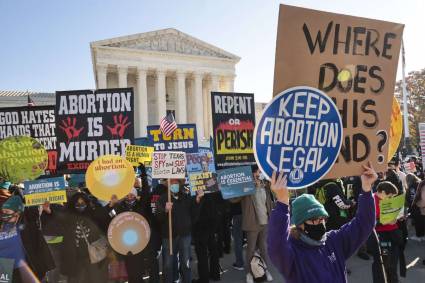
A divided society: this is how they demonstrated last December in front of the Supreme Court for and against abortion. Autor: AFP Publicado: 02/07/2022 | 09:38 pm
In the 1950s, in my neighborhood in Vedado, where apartment buildings and some residences for middle-class professionals were being built on barren land and on land occupied by citadels or old houses that were being demolished, a family with two high-rise apartments was the talk of the town when their purpose was “leaked” there.
The doctor who owned the building had his private practice and clinicthere for an exclusive clientele, American ladies who were spending a “vacation on the Caribbean island”, destined to have an abortion, all as discreetly as money allowed, to circumvent the laws of her country, which prohibited that medical practice and as did the laws of Cuba.
The interruption of pregnancy was only declared free and legal in Cuba in 1961. It was a clear and fair vision of the woman’s right to decide about her body and the possibility of doing it without taboos and in a safe way for life. This was put into practice from 1965 in the National Health System. It is said that pregnant women’s mortality due to illegal and unsafe abortions decreased to practically zero.
It was in 1973 that the United States succeeded, after a judicial struggle initiated in 1970, in legalizing abortion when Jane Doe, the pseudonym used by Norma Leah McCorvey, a woman from Dallas, denounced Henry Wade, district attorney of that Texas city, to demand her right to have an abortion – she had two children and her lawyers filed her petition because she had been raped – and the judges of the highest judicial authority in the United States ruled in favor of making abortion a constitutional right.
Nearly two decades later, in 1992, that decision was reaffirmed by the Supreme Court in Planned Parenthood v. Casey in a 5-4 vote. However, the most backward segments of a deeply puritanical society, often associated with religious beliefs, persecuted medical personnel, activists and women alike for the practice of women’s free reproductive rights.
Attacks on clinics, assassinations, and individual threats, were also coupled with judicial persecution. According to data from the National Advocates of Pregnant Women (NAPW), a women’s legal defense organization, since 1973 more than 1,700 women have been imprisoned or detained and prosecuted for the criminalization of pregnancy.
Of course, NAPW is concerned about what may happen from now on, when the Supreme Court overturned the Roe v. Wade ruling, and termination of pregnancy will no longer be a constitutional right, Each of the 50 states of the Union will impose the rules and limits on pregnant women, which translates into 166 million women in the United States being in their hands and unable to make decisions over their bodies and lives.
In this summer of 2022, what was believed for 49 years to be a step forward and definitive, was cut short by the 6-3 decision of the current Supreme Court. It was tailored to the stalest mold and extreme traditionalism of a good part of American society, because President Donald Trump was able to appoint three of the nine judges, tipping the balance in such a way that leaves a legacy of right-wing thinking and decision-making power that will weigh on American society for many years, since the terms of a Supreme Court justice is for life.
Now women who need or want to terminate a pregnancy will have to travel to the “liberal” states where it is allowed or to neighboring countries such as Canada and Mexico, for example, in order to make their own decision. Some commentaries emphasize how the persecution and trials could lead them to prison, even with accusations of murder or manslaughter.
A commentary in The Hill, signed by Liberty Vittert, under the headline “The biggest danger in overturning Roe: your phone could send you to prison,” warned, “You’re scared, you’re alone and you’re pregnant. You can’t keep the baby and you want an abortion. However, the state you live in had a trigger law that automatically made abortion a crime when the Supreme Court overturned Roe v. Wade last week. You decide to have an abortion anyway at a clinic that is still doing it 100 miles from your hometown.
“Now you’ve committed a crime, and the police have a new arsenal of evidence to arrest you at their disposal. Did you use Google Maps or Waze to drive to the clinic? Police can get warrants or subpoenas to get your Apple or Google cell phone location data to see where you went and how long you stayed there. Did you stop using your period-tracking app? Law enforcement can get that data. Did you Google an abortion clinic? Law enforcement can get that data.”
Although hypothetical, not fiction as related, abortion has once again been criminalized and any action linked to it is considered a crime or offense, can be investigated, prosecuted and convicted and since the Supreme Court made its ruling final, “trigger laws” banning the medical procedure have already gone into effect in several states.
Objectively, the Supreme Court’s action has divided the nation, and demonstrations for and against it came face to face in front of the Temple of Justice, a monumental marble edifice whose quarries of provenance almost identify the current ideological makeup of the nine justices: those stones came from Vermont, liberal and politically independent-minded; from Georgia, the state that was the icon of segregation; from Alabama, which continues to recall the black belt of slavery in its cotton fields; from Spain, where Franco’s phalanx drowned a people; and from the fascist Italy of Benito Mussolini, to whom the architect builder thanked for his marble contribution.
A first step on a path of retrogression
This overturning of Roe v. Wade is only the first back-to-the-darkness ruling by the U.S. Supreme Court in a series that will undoubtedly transform the country. The warnings about this retrograde process have been coming ever since Trump began appointing conservative justices and upsetting the balance.
Already, New York Democratic Rep. Carolyn Maloney, chair of the House Oversight and Reform Committee has scheduled a July 13 hearing on the impact of the reversal of Roe v. Wade, which she called having “devastating effects” for generations. She sees it as the culmination of a years-long public campaign by Republicans to appoint a Supreme Court that would uphold draconian restrictions on people’s reproductive health care.
Naomi Klein, a leading scholar and environmentalist, asserted in an article in The Intercept that the United States is in the midst of a “shock-and-awe judicial coup,” a military term for a surprise and frightening attack that allows for quick victory over an adversary that has been terrorized by the power of force, in this case by the force of power. We cannot ignore the fact that a Supreme Court decision is not subject to appeal.
To the blow to abortion rights, Klein added the blow to gun control laws and the authority of the federal government’s Environmental Protection Agency to regulate greenhouse gas emissions from the use of fossil fuels, to the benefit of exploitative corporations, even to the detriment of the sovereignty of indigenous nations in the U.S.
It is not new and her warning that can be read in her major study The Shock Doctrine: The Rise of Disaster Capitalism [In its Cuban edition: “La Doctrina del Shock: El auge del capitalismo del desastre”, published in Cuba by Editorial de Ciencias Sociales, 2016.] On the Supreme Court’s docket there are other issues of impact, even affecting democracy itself, the right to vote, the redrawing of electoral districts and these judges do not seem to be precisely neutral….
It is clear that American democracy is deteriorating and on the part of the Supreme Court, the process is underway. There will still be much to tell and to analyze.
A weekend amid shootings and price hikes

A weekend amid shootings and price hikes
Things are not going well in the U.S. for the citizens who will vote in November. Pocketbooks are being ripped out, while schools, hospitals, religious institutions and even funerals are being targeted by shooters.
Author:

Juana Carrasco Martín | juana@juventudrebelde.cu
Translated and edited by Walter Lippmann for CubaNews.

Gasoline in Los Angeles. Author: Taken from Antiwar.com Published: 04/06/2022 | 09:11 pm
In Los Angeles, the host city in a few days of the Summit without the Americas, as many have labeled it because of the selective exclusion decreed by President Joseph Biden to three sovereign nations in the region, the price of fuel at a downtown gas station reached more than eight dollars a gallon and prices continued to rise throughout the United States.
Meanwhile, the price of a barrel of crude oil in the European market closed at $117.60, its highest price since March 23, and much had to do with the sanctions imposed on Russian exports due to Washington and NATO’s confrontation with the Kremlin and the war situation in Ukraine.
Crude oil costs account for just over half of the pump price, according to the U.S. Energy Information Administration. The rest of the price includes the other components of gasoline, production costs, distribution costs, overhead costs for everyone involved in production, distribution and sales, taxes and California carbon offset fees paid by refineries, City News Service said in releasing the increase that hits Americans’ pocketbooks hard.
The national average price of gasoline rose to a record high of $4.62 dollars, and it is no secret that this increase directly affects the cost of food, and a wide range of goods and services, so it has not been the only product that continues to rise.
The New York Times warned at the beginning of May that “the era of abundant cheap products could be coming to an end”, and went back to the pandemic in search of the causes. This is because, since then, the supply of goods has been severely limited and, consequently, prices have risen, with the aggravating factor that economists warn that this situation could persist, when the COVID-19 and the war in Ukraine affect international trade and inventories are difficult to fill.
Hence, inflation is affecting the global economy, practically without exception, including that of the United States which, moreover, many of whose corporations, in search of higher profits, have taken their industries to foreign territories and now ordinary Americans are paying double the consequences.
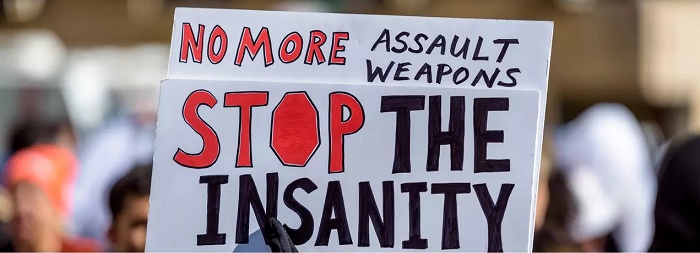
March for life against guns.Photo: Getty Images.
This rise in the cost of living is one edge of the Sword of Damocles hanging over the Democrats in the upcoming November elections, though not the only looming threat to that party. Mass shootings must be taken into account. These are much more than a problem of politicians-not public servants since they constitute an ultimatum to American society about its degradation as a nation.
The United States debates, once again and apparently with the same disappointing conclusion, how to reverse the violence that is expressed in the shootings that are leaving a trail of unfortunate deaths and, in just a week, the shootings have skyrocketed.
As of this Saturday, June 4 and so far in 2022, there have been 234 mass shootings in the United States, defined as when four or more people, not including the shooter, are injured or killed. Not a single week has gone by in 2022 without at least four mass shootings, according to Gun Violence Archive records, and at the end of May, they counted 256 people killed and 1010 injured. June began with the same criminal figures.
Saturday, June 4: Centerville, a Texas community is shaken after five members of a Houston-area family were found murdered in the Collins family cabin, a crime described as “unspeakable” that took the lives of three brothers, Carson, 16, Hudson, 11, and Waylon Collins, 18; their cousin Bryson, 11; and their grandfather Mark Collins, 66.
The killer, Gonzalo Lopez, a member of a Mafia group sentenced to two life sentences for murder in Hidalgo County and attempted capital murder in Webb County, had escaped from prison three weeks earlier. I was unable to find out what weapon was used in the crime.
More of a shock seems to be the emotional status of the U.S. citizenry. On Thursday, June 2, two separate shootings occurred in the Midwest. One in the parking lot of Cornerstone Church in Story County, Iowa, where Jonathan Lee Whitlatch, 33, shot two women in the congregation, Eden Mariah Montang, 22, and Vivian Renee Flores, 21, while a program was in progress inside the church. He then killed himself.
The other occurred in Racine, Wisconsin. Two women were shot at Graceland Cemetery Thursday afternoon during a funeral for a man who was killed by police last month. Residents heard between 20 and 30 gunshots before 2:30 p.m. as loved ones gathered to remember Da’Shontay L. King Sr. a 37-year-old Black man who was shot and killed by police after a foot chase following an attempted traffic stop on May 20, according to the Racine Journal Times. The identity of the attacker, apparently still on the run, was not released.
Gunshots and wails are still heard from the Buffalo supermarket massacres, from Robb’s Elementary School in Uvalde, and from fallen medical personnel at a Tulsa hospital. As America shudders, politicians are shaking in their boots to stand up to gun producers and their blackmailing arm, the National Rifle Association-NRA, or jingle in their pockets.
The President of the United States is waiting for Congress to decide on a proposal that barely promotes raising the age to 21 to legally purchase a gun. Hardly a band-aid for the deadly wounds caused by daily shootings, and possibly not even that will be granted by those who take refuge in the Second Amendment of the Constitution.
Shame on Biden’s words in a speech calling for the (unlikely) passage of the scrawny, rickety, flimsy reform: “I respect the culture, tradition and concerns of lawful gun owners,” and as if to cleanse himself, he added: “At the same time, the Second Amendment, like all other rights, is not absolute.”
It is very difficult to be with God and the Devil… and the voters, 97 percent of whom are in favor of some kind of limit or control on gun violence in their streets, schools, workplaces and homes, are pushing back.
Jim Carrey and the “Yes” to Socialism

FROM THE LEFT
Jim Carrey and the “yes” to socialism
The words of the famous American actor Jim Carrey, in which he advocates socialism, have given a lot to talk about on social networks on the Internet and in the mainstream media for several weeks. The supposed defenders of “freedom of expression” have unleashed all sorts of attacks against him.
———————————————————————–
Author: Jorge Ángel Hernández | internet@granma.cu
October 7, 2018 20:10:40
A CubaNews translation.
Edited by Walter Lippmann.
Throughout its history, the democracy of political parties has proclaimed its defense of freedom of expression. It appears as a citizen’s right in all constitutions. To make matters worse, it has been used with great manipulative intelligence since the Cold War.
Thus, a pattern of appreciative judgment has been achieved that, as the 21st century goes by, accuses the emerging socialisms of being dictatorships as it assumes that capitalism guarantees freedom.
The reality is quite different, since the contradiction with which public opinion is pressured imposes a terrorist response, even to the most advanced models of socialism, without ruling out public condemnations based on diverse judicial subterfuges; practices completely normalized today that impose a condemnation of socialism historically and towards the far future. In other words, to infinity and beyond.
This has been done in South America, even with center formations that only apply measures of humane capitalism, such as the Argentina of the Kirchners.
Suddenly, the well-known actor Jim Carrey said on HBO: “We have to say yes to socialism -“to the word and everything”-and the true reactions which that freedom of expression have generated.
Fox’s review starts by discrediting him as a confessed Hollywood destroyer. It artificially superimposes on Carrey’s declaration, Fox’s own claim that Venezuelan socialism is a failed system, in which thousands of people suffer the worst living conditions on a daily basis.
The Fox reporter who assumes these words is not aware of the plans for housing, health, education, culture nor, of course, of the terrorist interference and mercenarism – in successive boycotts of the national economy and in real and concrete attacks – with which they have tried to besiege Bolivarian socialism.
If you look at it, Carrey’s focus does not delve into socialism itself, but calls for resistance to the insanity of the regime in power in the U.S. It takes as a formula the very system of political parties of U.S. democracy. It is a call to shake off the predetermined aggressiveness between Republicans and Democrats in the United States.
But the reaction has been brutal: exercising freedom of expression, in the context where the actor usually operates, could cost him his career, among the brightest and best paid in the film industry today, if he depends on this terrorist machinery of information. This is how many Venezuelan bigots manipulate and respond wherever the news appears.
For the democracy of political parties, led by the American one, the word -and only the word-, “socialism” represents the satanic in all dimensions.
Carrey has made it clear in his comments that whoever uses it must apologize, that it is vetoed from the supposedly democratic vocabulary. And that is what those who hijack the idea of freedom of expression to make it a hostage and client of their own oppression immediately bet on.
McCarthyism is still alive and those who dare to cross the fine line of censorship will have to face terrorist smear campaigns and the manipulation of justice.
For this reason, we must not only say yes to the word “socialism,” but to everything else that the system proposes and facilitates in the emancipation of the classes that are still oppressed by capital. Jim Carrey is absolutely right. (Taken from La Jiribilla)
“A pattern of appreciative judgment has been achieved that, advancing in the 21st century, accuses emerging socialisms of dictatorships.
“Exercising freedom of expression, in the context where the actor usually operates, could cost him his career, among the brightest and best paid in the film industry today, if he depends on this terrorist information machinery.
Cuban poet, narrator and essayist. Villa Clara, 1961. Collaborator of several press media. Directed the culture magazine Umbral, by Villa Clara. He received the Distinction for National Culture in 2004.
Photo from La Jiribilla:
March for Our Lives – Los Angeles 2018
March for Our Lives – Los Angeles, March 24, 2018
A few notes and reflections
by Walter Lippmann, March 26, 2018
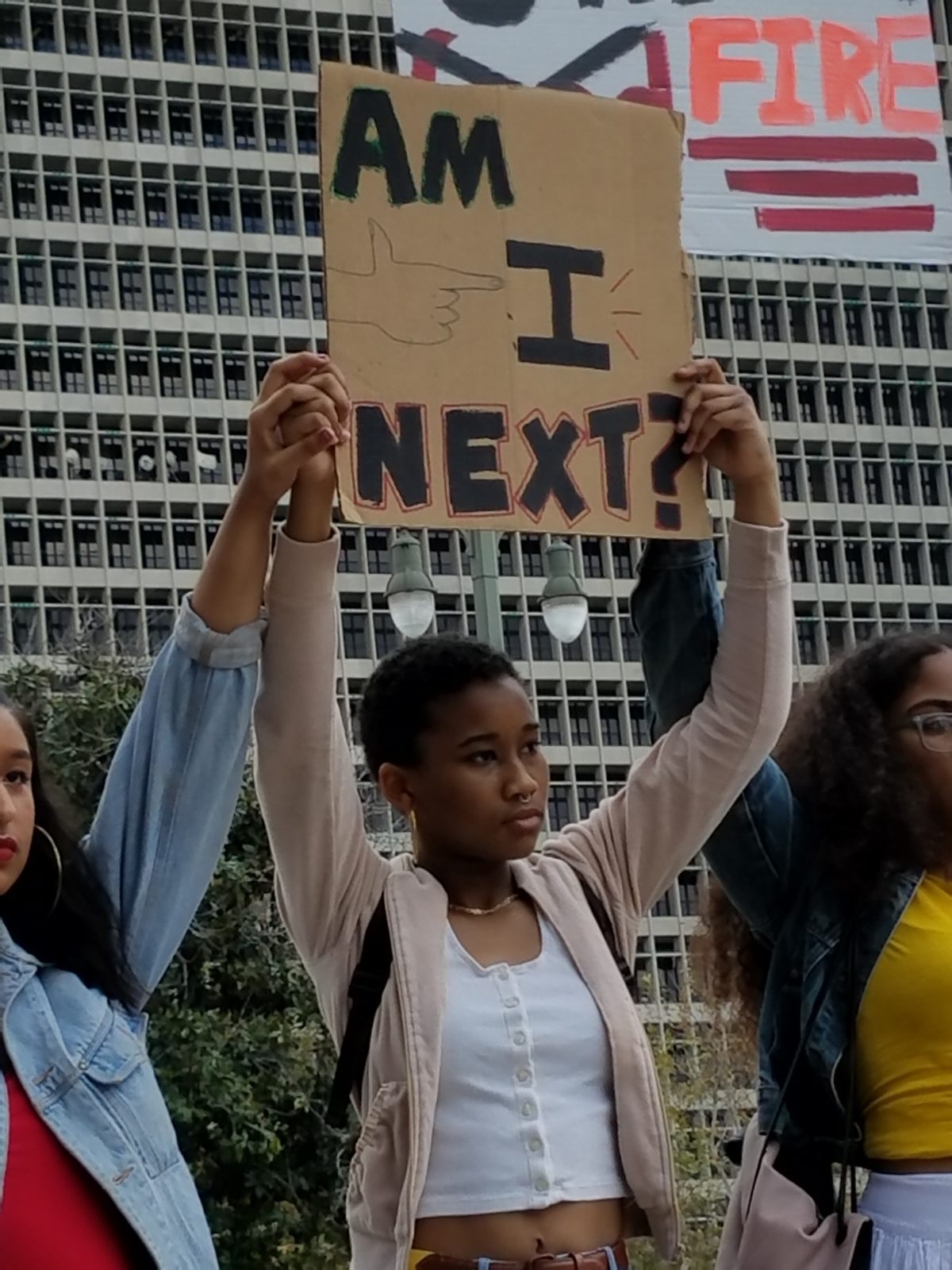
March for our Lives 2018 Los Angeles
Many more images may be viewed here:
https://walterlippmann.com/march-for-our-lives-los-angeles-photos/
The march was so big it was impossible to tell at any one point how many there were. If I’d had a helicopter, perhaps… Tens of thousands were reported. Here’s the LA TIMES report:
Tens of thousands gather in downtown Los Angeles for March for Our Lives rally
http://www.latimes.com/local/lanow/la-me-ln-los-angeles-march-20180324-story.html
Los Angeles Mayor Eric Garcetti spoke. Here’s a video of his speech:
Follow Their Lead
Young people across America are showing extraordinary leadership in the movement to end gun violence — and it was a privilege to join tens of thousands downtown on Saturday for the March for Our Lives.
We may be hearing lot of talk about the power of the Second Amendment, but our young people are showing how powerful the First Amendment makes us — because they are unstoppable when they speak up and speak out. This day will be written about in the history books, and their children will read about a generation that stood up to the gun lobby and said, ‘Enough is Enough’ and ‘Never Again.’
https://www.facebook.com/MayorOfLA/videos/10156240348049806/
We are witnessing a new layer of young people, quite massive, being drawn into activity, many for the first time in their lives. And they’re coming out for a very practical and simple reason. These mass shootings and the media’s promotion of these killings have got students afraid for their very lives, and with very good reason! So these young people are acting from the most universal material interest: the right to be alive.
DEMOCRACY NOW covered the entire march. Here’s their four-hour report:
https://www.democracynow.org/live/watch_democracy_now_march_for_our
A culture shift is opening up in the country with popular revulsion against violence taking various interesting and surprising new forms. Though posed, for now, as a response to the school massacres, it represents a broader turn against violence, it seems to me. Look at these pleasantly surprising headlines as examples of the shift:
Citigroup Sets Restrictions on Gun Sales by Business Partners
https://www.nytimes.com/2018/03/22/business/citigroup-gun-control-policy.html
YouTube to Ban Videos Promoting Gun Sales
https://www.nytimes.com/2018/03/22/business/youtube-gun-ban.html
It’s of course much easier to organize a protest when the authorities are all in favor of what you are doing, as in this case. The cops were on good behavior. I’m sure no one was arrested. A handful of right-wing Trumpsters had a counter-rally, but the protest was well-monitored by its own people. The cops were there, too, but the counter-event was small and basically uneventful. This reflects the evident split among the wealth and powerful who control the United States today.
The dominant mass media (NY Times, LA Times, NPR, etc) are all enthusiastic about these mobilizations. They hope to steer them into support for electing Democrats in the fall. Given the absence of any broad left electoral alternative to the two dominant parties, that strategy probably will prove effective, certainly in the short term.
This kind of comment by some government officials and the enthusiastic reporting we see in the dominant media means that the parameters for discussion of these issues is now broader, much broader than it’s ever been. And that follows the stream of shootings at schools in the US which seem to be on hold, for the moment.
After the ‘March for Our Lives,’ Student Activists Focus on Midterm Elections
Organizers of the movement for stricter gun laws plan to travel across the U.S. and register young voters for November elections
https://www.wsj.com/articles/after-the-march-student-activists-look-to-midterms-1522012947
It’s quite striking, to see the way the dominant media is more and more openly partisan in its support for the Democrats and in its red-baiting campaign against Vladimir Putin and Donald Trump. So who do the Trumpsters watch? I guess FOX NEWS, RUSH LIMBAUGH and the like. I rarely look at such media. But there are millions of people who do get their news through such vehicles, and, as Trump’s election demonstrated, many of them do get out and vote.
Particularly impressive was the care and consciousness with which the organizers made sure to include Black Lives Matter and other Black activists to speak prominently from the platform, in Washington, and in other cities. And they understood the importance of preventing efforts to pit Black against white in the movement against gun violence.
When asked what the biggest mistake the media had made in covering the Parkland students’ work, student leader David Hogg told Axios, “Not giving black students a voice. My school is about 25% black, but the way we’re covered doesn’t reflect that.” (According to the Broward County School District’s website, around 40% of the students who attend schools in the district are black. Individual school statistics were not available for MSD on Broward County’s website.)
There’s a long history of black teenagers fighting for gun control as part of the Black Lives Matter movement’s efforts to draw attention to police brutality. Activists like Kenidra Woods, Nza-Ari Khepra, Clifton Kinnie, and Parkland student Nick Joseph have been working on the issue in Parkland, Chicago, and Ferguson, Missouri. And they have wisdom to share from their time as activists.
https://www.teenvogue.com/story/parkland-survivor-david-hogg-media-not-giving-black-students-voice
While I didn’t see any literature from the MARCH FOR OUR LIVES in Spanish, the event was very favorably reported in LA OPINION, our local Spanish-language daily here in Los Angeles, as well as in HOY, the free paper which the LA TIMES gives out to compete with LA OPINION. Here’s an example, one of many:
THOUSANDS MARCH FOR GUN CONTROL IN CALIFORNIA
Miles de personas marchan en California a favor del control de armas
Los participantes pidieron medidas efectivas para evitar que más gente siga muriendo en tiroteos
https://laopinion.com/2018/03/24/miles-de-personas-marchan-en-california-a-favor-del-control-de-armas/
Six of the most powerful orators at the March for Our Lives
http://www.hoylosangeles.com/latimesespanol/la-es-seis-de-los-mas-poderosos-oradores-en-la-manifestacion-march-for-our-lives-20180325-story.html
Another element which hasn’t been explored much, in the English-language media, is the ethnicity of the best-known of the young student leaders, Emma González, though it is beginning to be discussed in the Spanish-language media. Some of these profiles are sympathetic, others very hostile.
Examples:
https://oncubamagazine.com/sociedad/marcha-la-vida/
https://oncubamagazine.com/noticia/marchan-ee-uu-la-vida/
As well as in the Cuban media at home on the island.
https://walterlippmann.com/us-students-strike-for-gun-control/
https://walterlippmann.com/usa-emma-short-hair-and-bare-feet/
Never again! The students’ cry against guns in the United States!
https://walterlippmann.com/never-again-the-students-cry-against-guns-in-the-united-states/
The pro-gun right-wing is starting to attack this anti-violence movement and its leadership.
Examples:
No, Emma Gonzalez Isn’t Tearing Up the Constitution in That Viral Video
https://www.glamour.com/story/emma-gonzalez-not-tearing-up-constitution-in-viral-video?
Fake photo of Parkland shooting survivor tearing up US constitution is spread online:
https://www.indy100.com/article/fake-photo-emma-gonzalez-us-constitution-parkland-shooting-survivor-activist-gun-violence-march-for-8273206
Whatever the reasons, a decline in gun culture in this country can only be a good thing for society. Some stores which have sold guns in the past are beginning to have second thoughts. Some have stopped selling guns. For them, perhaps, because changing attitudes make it bad for business. Examples:
YouTube to Ban Videos Promoting Gun Sales
Citigroup Sets Restrictions on Gun Sales by Business Partners
https://www.nytimes.com/2018/03/22/business/citigroup-gun-control-policy.html
Whatever the reasons, a decline in gun culture in this country can only be a good thing for society.
The historic gun culture (cowboys, John Wayne, etc.) of this country, whose founders and subsequent rulers have kept control through violence since the country’s foundation. It can’t be ended in a day or a week or a year. Profound social change is necessary to make that possible. But every step we can take now is a move in the right direction.
Ask yourself, does any private citizen need an AR-I5 at home? Such a device has nothing to do with self-defense. It’s ONLY purpose is to kill people.
Below you will find some photos I took, mostly at the march on Saturday, a few Sunday morning of some posters I’d picked up at the end, and the front pages of the Sunday NY TIMES and LA TIMES. For years I’ve made it a practice at such demonstrations to collect discarded posters to donate to the Center for the Study of Political Graphics.
It’s a remarkable institution which collects and mounts theme-based exhibitions of political protest posters. I’ve turned over many more since my first donation of about a thousand posters some 20 years ago. You can, AND SHOULD, donate any old posters (young ones also accepted). US residents can even get a tax deduction. More importantly, if you have posters and they are sitting in the garage not being seen by anyone, they could get mildewed and eventually will only be good to be thrown out. Check them out here: http://www.politicalgraphics.org/
Walter Lippmann
Los Angeles, California
March 26, 2018
March For Our Lives – Los Angeles – Photos
March for Our Lives – Los Angeles, March 24, 2018
by Walter Lippmann, March 26, 2018
The following pictures were almost entirely taken by me on a Samsung Galaxy S7 cell phone. A few with me were taken by people at the march who kindly took pictures of me with other people. I hope you will enjoy these images. There are twenty-eight.
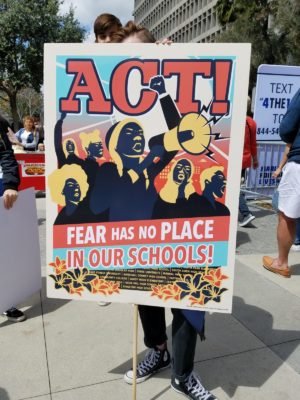
The Hackneyed Imperialist Tool of Demonization
The Hackneyed Imperialist Tool of Demonization

By Manuel E. Yepe
http://manuelyepe.wordpress.com/
Exclusive for the daily POR ESTO! of Merida, Mexico.
Translated and edited by Walter Lippmann.
“The systematic dehumanization of the leaders of other countries; the routine exaggeration of their military capabilities; the monotonous falsification of the nature and attitudes of other peoples; the reckless application of double standards in comparing the conduct of others with our own, as well as the inability to recognize the common character of many problems of others with our own, and the consequent tendency to see all aspects of the relationship with others in terms of a total and irreconcilable conflict of concerns and purposes. These, I believe, are not signs of the maturity and discernment that can be expected in the diplomacy of a great power…”.
Although the above description may seem applicable to Washington’s current foreign policy, it is a warning that George Frost Kennan (1904-2005), a long-serving diplomat and American historian, reminds us of the fact that it was Kennan who formulated and advocated a “policy of containment” against alleged Soviet expansionism, but later changed his theory.
Kennan enunciated his “containment policy” in February 1946 in a text that is remembered as the long message (“the Long Telegram”) he sent from Moscow in 1946 against so-called Soviet expansionism at the end of World War II. The text, signed with just one “X”, appeared in the July 1947 issue of Foreign Affairs magazine, intended to analyze the structure and psychology of Soviet diplomacy at that time. It was widely disseminated by Washington and brought Kennan a lot of popularity in the academic world.
Shortly after that same year, he was appointed director of policy planning at the State Department and, in 1949, advisor to that department. He returned to Moscow in 1952 as his country’s ambassador and in the following year, he had to return to the United States after being declared persona non grata by the Soviet government.
In the late 1950s, Kennan revised his views on “containment” and began advocating a program of “disengagement” from areas of conflict with the Soviet Union. He later emphatically denied that containment was applicable tp situations in other areas of the world, such as Vietnam.
Kennan is identified as one of the architects of the Cold War. His postwar writings about the supposed Soviet threat nurtured the U. S. policy of containment that led to the devastating arms race that still threatens the world with utter destruction.
But the development of events and variables in Washington’s foreign policy led Kennan to reconsider his initial views and to formulate those with which he begins this article.
Kennan then suggests that, although the Russians were still fundamentally opposed to peaceful coexistence with the West and inclined to achieve the extension of the Soviet socialist system around the world, they were particularly sensitive to the logic of military force and will respond or retreat in the face of skillful and determined resistance to their wishes for expansion.
Thus, Kennan goes on to advocate a policy of “counter-pressure” where the Soviets threatened or it could be predicted that such counter-pressure could lead to the Soviets being willing to cooperate with the US or, eventually, be seen to lead to an internal collapse of the Soviet government. This point of view would eventually become the focus of US policy towards Russia.
It is remarkable how much the imprint of Kennan’s policy of containment has influenced U. S. imperial policy, despite its belated retraction. It is something that can be noticed in the current stage of Washington’s hegemonic decline with an almost identical performance in the manner of demonizing its enemies or those who do not agree with its designs.
It is as if the complacent media and the two political parties that govern alternatively could only agree to attack their opponents when they have fabricated an image that fits into certain diabolical and perverse preconceived patterns.
In Latin America, the current U. S. offensive against dissident governments in its hegemonic area goes through a period of great intensity in which Bolivarian leader Nicolás Maduro Moro, president of Venezuela, occupies the prominent place that for half a century had Cuba sitting in the chair of the accused. The head of the Caracas government has reached, if not surpassed, the level of gossip that Fidel and Raúl Castro used to have, although the latter do not escape today from the diarrhea of lies and dehumanizing insults of Donald Trump.
February 27, 2018.
Ambitious Neo-Conservative Conspiracy
- English
- Español
Ambitious Neo-Conservative Conspiracy

By Manuel E. Yepe
http://manuelyepe.wordpress.com/
A CubaNews translation.
Edited by Walter Lippmann.
“America is a weapons factory, the White House a war room, and the president the manager of the neoliberal conspiracy to re-colonize the planet. It exports war and mass poverty. On the economic front: usurious neo-liberalism; on the military front: illegal wars. These are the trenches of America’s battle for world domination in the 21st century. If not stopped, it will be a short century.”
The above was written by film critic and Edinboro University Pennsylvania professor Luciana Bohne in a documented essay on the aggressiveness deployed by the US to assert its global hegemony.
In the 19th century, the United States posed as the nation chosen by God though Manifest Destiny to expand its domination throughout the world for the good of humanity. It decided to exterminate the internal “red menace” writing and shredding treaties, stealing lands, massacring, and herding indigenous populations into concentration camps (known as “Indian reservations”), in the name of civilizing the “savages.”
In 1890, with the massacre of Lakota at Wounded Knee, the frontier land grab completed Washington’s internal imperialist aspirations. But there remained a world to conquer, and the US trained its exceptionally covetous eye on Cuba and the Philippines, then part of Spain’s decadent colonial system. US external imperialism was born, wrote Bohne.
“Then, in 1917, something happened: a successful socialist revolution in Russia, the second major attempt, after the French Revolution of 1789, to try to redistribute the wealth of the few to the advantage of the many. The rulers of the world –the US, Britain, France and sundry acolytes– put aside their differences and united to stem the awful threat of popular democracy rising and spreading. They invaded Russia, fomented a civil war, funded and armed the counter-revolutionary forces, failed, and tried again in 1939,” wrote Bohne.
“But Hitler’s war of extermination against the USSR ended in a spectacular victory for Moscow.
For a while, after 1945, the US had to behave as a civilized country, formally. It claimed that the USSR had a barbarian, all-conquering ideology, rooted in terror, disappearances, murder, and torture. By contrast, the US was the shining city on the hill, the beacon of hope for “the free world.” Its shrine was the United Nations; its holy writ was international law; its first principle was the inviolability of the sovereignty of nations.
All this was rubbish, of course. It was an apartheid society. It nuked Japan not once but twice, deliberately selecting civilian targets. It shielded from justice top Nazi war criminals from justice in order to absorb them as partners in its intelligence structures. It conducted virtual “show trials” against dissidents during the hysteria of the McCarthy congressional hearings, seeding the country with a harvest of fear.
It waged a genocidal war on Vietnam to prevent that country’s independence and unification. It assassinated African independence leaders and bestowed fascist dictators on Latin America. It softly occupied Western Europe, tied it to itself through military “cooperation” through NATO, and continued its ruthless effort to take out the Soviet Union and crush self-determination in the colonial world.
The Soviet Union dissolved in 1991, and the US went berserk with triumphalism. The conquest of the world, interrupted in 1917, could resume.
The benign mask dropped. “History had ended, ideologies had died, and the messianic mission of the US to become the steward of God’s property on earth could be fulfilled.”
An ambitious neo-conservative conspiracy drafted “The Plan for a New American Century” (PNAC). It envisaged the 21st century as a unilateralist drive to entrench American values globally through pre-emptive wars and regime change.
This frenzied delirium of US military domination turned into official foreign policy with the Bush Doctrine after the terrorist acts on 9/11 in New York. But it would be the Clinton administration’s Doctrine of Humanitarian Warfare –combining the liberal principles of “democracy and freedom” with policies of human rights– that induced the liberal left to embrace war and imperialism as the method of defending human rights.
“Since 1945”, wrote Bohne,” America’s Manifest Destiny, posing as the Free World’s Crusader, has claimed 20 to 30 million lives worldwide and bombed one-third of the earth’s people.”
May 30, 2016.
Spanish Headline Here

Por Manuel E. Yepe
http://manuelyepe.wordpress.com/
“Estados Unidos es una fábrica de armas que exporta guerra y pobreza a las masas, la Casa Blanca es un cuartel y el presidente de la nación es el jefe de la conspiración neoliberal para recolonizar el planeta. En el frente económico, Washington es el prestamista del
neoliberalismo; en el frente militar, promotor de guerras ilegales. Estas son las trincheras de su batalla por la dominación del mundo en el siglo XXI. Si no se le detiene, será un siglo corto.”
Esto dice y pronostica Luciana Bohne, crítica de cine y profesora de la Universidad de Edinboro, en Pensilvania, en un documentado ensayo acerca de la agresividad que despliega Estados Unidos en función de afirmar su hegemonía global.
En el siglo XIX, Estados Unidos, presentándose como la nación escogida de Dios por destino manifiesto para expandirse por el mundo y dominarlo para bien de la humanidad, decidió exterminar la “amenaza roja” interna. Forzó inicuos tratados y destrozó otros que no eran de su conveniencia, robó tierras, masacró poblaciones nativas, convirtió fincas de pastoreo en campos de concentración (reservas indias), todo en nombre del propósito de civilizar salvajes.
En 1890, con la matanza de Wounded Knee, su vocación imperialista completó la fijación de la frontera nacional que en lo interno llenaba sus aspiraciones. Pero quedaba un mundo por conquistar y el naciente imperialismo global estrenó su codicia con la conquista de Cuba, Puerto Rico y Filipinas, que eran parte del decadente sistema colonial de España. Nació el imperialismo externo norteamericano, escribe Bohne.
En 1917, dice la autora, “ocurrió una revolución social en Rusia, la segunda tras la francesa de 1789 que se proponía redistribuir la riqueza de los pocos para beneficio de los muchos. Estados Unidos, Gran Bretaña, Francia y otros acólitos, dejaron a un lado sus diferencias y se unieron para detener la terrible amenaza que planteaba la democracia popular y su difusión. Invadieron Rusia, fomentaron una guerra civil, financiaron y armaron a las fuerzas de la contrarrevolución. Cuando fracasaron, lo intentaron de nuevo en 1939. Pero la guerra de Hitler por el exterminio en la URSS terminó con espectacular victoria de Moscú”.
Por un tiempo, después de 1945, Estados Unidos tuvo que comportarse formalmente como un país civilizado. No obstante, desarrolló una campaña contra la URSS alegando que tenía una ideología de exterminio, terror, asesinatos y torturas. Estados Unidos, por el contrario, era un faro de esperanza para el “mundo libre”. Su Santuario estaba en las Naciones Unidas; su Sagrada Escritura en el derecho internacional, y era su principio básico la inviolabilidad de la soberanía de las naciones.
Todo esto, aclara Bohne, era pura falacia. Estados Unidos era una sociedad de apartheid que había sido capaz de llevar a cabo bombardeos nucleares -dos veces-, sobre objetivos civiles de Japón cruelmente seleccionados. Evitó que se hiciera justicia a los criminales nazis al finalizar la guerra para absorberlos como socios en las estructuras de su inteligencia militar. Llevó a cabo juicios mediatizados contra disidentes durante la histérica era macartista, sembrando al país para una cosecha de miedo. Libró una guerra genocida contra Vietnam para evitar su independencia y unificación. Asesinó a líderes
independentistas africanos y promovió dictadores fascistas en América Latina. Ató a Europa occidental mediante acuerdos de “cooperación” militar en la OTAN y libró un esfuerzo implacable por debilitar a la Unión Soviética y aplastar la autodeterminación en el mundo colonial. La Unión Soviética se disolvió en 1991 y Estados Unidos lo celebró con triunfalismo. La conquista del mundo, interrumpida en 1917, podría reanudarse.
Cayó la máscara benigna. “La historia había terminado, las ideologías habían muerto y podría cumplirse la misión mesiánica de Estados Unidos, convertido en el administrador de la propiedad de Dios en la tierra”.
Una ambiciosa conspiración neoconservadora bosquejó el “Proyecto para un nuevo siglo americano (PNAC)”, que pronosticó que el siglo XXI sería el del afianzamiento mundial de los valores estadounidenses mediante guerras preventivas y cambios de los regímenes que no fueran afectos a ellos.
Este frenético delirio de dominación militar de Estados Unidos se convirtió en política oficial con la doctrina de Bush después de los actos terroristas del 11 de septiembre en Nueva York, aunque antes tomó cuerpo en la doctrina de la guerra humanitaria aplicada por Clinton que mezcló los principios liberales de “democracia y libertad” con las políticas sobre derechos humanos para inducir a la izquierda liberal a abrazar la guerra y al imperialismo como medios de defensa de los derechos humanos.
Desde 1945, dice la autora del artículo, el destino manifiesto proclamado por Estados Unidos como cruzada del mundo libre, ha cobrado las vidas de entre 20 a 30 millones de personas y ha bombardeado a un tercio de los habitantes del planeta.
Mayo 30 de 2016.
Youth in the USA Reject Capitalism
- English
- Español
Youth in the USA Reject Capitalism

By Manuel E. Yepe
http://manuelyepe.wordpress.com/
A CubaNews translation.
Edited by Walter Lippmann.
A very recent survey by the elite and prestigious, Harvard University in Massachusetts, indicates that most young Americans reject the basic principles of the US economy and do not support capitalism.
This is a fact of major political importance, considering that, since the end of the Cold War, all US internal and external propaganda has had as its primary objective the formation of a free market-oriented consciousness and the protection of corporations and private capital in general, dismissing the social purposes of the state.
In fact, in its foreign policy, Washington conflates the terms “capitalism” and “democracy”, to the extent that it almost never uses the first term. Its capitalist allies in are called “democracies” and those who do not accept its global hegemony are not. It’s as simple as that.
The Harvard University survey, which polled young adults between ages 18 and 29, found that 51 percent of respondents do not support capitalism. Just 42 percent said they support it.
According to the pollsters, most respondents who said they don’t support capitalism said they were concerned about the unpredictability of the free-market system.
“Capitalism can mean different things to different people, and the newest generation of voters is frustrated with the status quo, broadly speaking.” Zach Lustbader, a senior at Harvard involved in conducting the poll, argues that “the word ‘capitalism’ doesn’t mean what it used to in the US. For those who grew up during the Cold War, capitalism meant freedom from the Soviet Union and other totalitarian regimes. For those who grew up more recently, capitalism has meant a financial crisis from which the global economy still hasn’t completely recovered.”
Although the information on the results of the survey, provided by Amy Cavenaile in The Washington Post on April 24, 2016, does not clarify what alternative socio-economic systems the young people in the poll would prefer, it indicated that 33% percent said they supported socialism. The survey had a margin of error of 2.4 percentage points.
A subsequent survey that included people of all ages found that somewhat older Americans also are skeptical of capitalism. Only among respondents at least 50 years old was the majority in favor of capitalism.
Although the results are startling, Harvard’s questions are in accord with other recent research on how Americans think about capitalism and socialism. In 2011, for example, the Pew Research Center found that people ages 18 to 29 were frustrated with the free-market system.
In that survey, 46 percent had positive views of capitalism, and 47 percent had negative views. As to socialism, by contrast, 49 percent of the young people in Pew’s poll had positive views, and just 43 percent had negative views.
On specific questions about how best to organize the economy, the Harvard poll found a greater influence of capitalist ideas among young people. Just 27 percent believe government should play a large role in regulating the economy, and just 30 percent think the government should play a large role in reducing income inequality. Only 26 percent said government spending is an effective way to increase economic growth.
Yet 48 percent agreed that “basic health insurance is a right for all people.” And 47 percent agreed with the statement that “basic necessities, such as food and shelter, are a right that the government should provide [it] to those unable to afford them.”
It has been considered that Bernie Sanders’ campaign for the Democratic Party nomination for the Presidential election has been a significant factor in the changes detected now. The fact that so many young people feel moved by the word of a candidate of such an advanced age was a great surprise.
What the polls are now showing about US youth is rather significant. It could be the prelude to major changes within and beyond the borders of the American superpower.
May 3, 2016.
Jóvenes en EEUU Rechazan el Capitalismo

Por Manuel E. Yepe
http://manuelyepe.wordpress.com/
Una muy reciente encuesta realizada por la elitista, aunque prestigiosa, Universidad de Harvard, en Massachussets, indica que la mayoría de los jóvenes estadounidenses rechaza los principios básicos de la economía de Estados Unidos y que no se consideran a sí mismos compatibles con el capitalismo.
Es este un dato de la mayor importancia política, razonando que desde el fin de la guerra fría toda la propaganda interna y hacia el exterior de Estados Unidos ha tenido como objetivo fundamental la formación de una conciencia orientada al libre mercado y a la protección de las corporaciones y el capital privado en general, con desdeño de los fines sociales del Estado.
De hecho, en su política exterior, Washington confunde los términos “capitalismo” y “democracia” a tal extremo que casi nunca utilizan el primero. Sus aliados en el capitalismo son “democracias” y los que no aceptan su hegemonía global no lo son, así de sencillo.
La pesquisa de la Universidad de Harvard, que encuestó a jóvenes estadounidenses de entre 18 y 29 años de edad, reveló que el 51% de ellos no apoya al capitalismo contra el 42 % que si es partidario de este sistema.
Según los encuestadores, la mayoría de los encuestados que dijo no sentirse compatibles con el capitalismo atribuyen sus discrepancias a los vaivenes del libre mercado.
“El capitalismo puede significar diferentes cosas para diferentes personas, y la generación más nueva de votantes está frustrada con el status quo, en términos generales”. Zach Lustbader, uno de los expertos de Harvard que condujo la encuesta, argumenta que el término “capitalismo” no tiene hoy en Estados Unidos el mismo significado que antes. A los que crecieron durante la Guerra Fría, les inculcaron la idea de que el capitalismo era un arma para liberar a la Unión Soviética y a otros regímenes totalitarios. Pero para otras
generaciones mas recientes el capitalismo ha significado una crisis financiera constante de la que la economía global aún no se ha recuperado.
Aunque la información sobre los resultados de la encuesta que brinda Amy Cavenaile en The Washington Post el 24 de abril de 2016, no aclara cuales otros sistemas socio-económicos preferirían los jóvenes como alternativa, se indica que el 33 % de ellos elegiría el socialismo. La encuesta tiene un margen de error de 2,4 puntos porcentuales. Un posterior estudio que incluyó a personas de todas las edades reveló que entre estadounidenses algo mayores también existe escepticismo acerca del capitalismo. Sólo entre encuestados que sobrepasan los 50 años de edad hubo una mayoría a favor del capitalismo.
Aunque estos resultados son sorprendentes, Harvard los compara con otros estudios recientes acerca de lo que piensan los estadounidenses sobre el capitalismo y el socialismo. En 2011, por ejemplo, el centro de Investigación Pew encontró que en personas de 18 a 29 años de edad existía mucha frustración con el sistema de libre mercado.
En ese sondeo se constató que el 46% de la ciudadanía tenía puntos de vistas positivos acerca del capitalismo, y 47 % tenía opiniones negativas. En relación con el socialismo, por el contrario, 49 % de los jóvenes en la encuesta de Pew tenían opiniones positivas, y sólo el 43 % tenían opiniones negativas.
La encuesta Harvard halló una mayor influencia de las ideas capitalistas en los jóvenes estadounidenses ante preguntas específicas sobre la mejor manera de organizar la economía. Sólo el 27 % cree que el gobierno debe jugar un papel importante en la regulación de la economía, únicamente el 30 % cree que el gobierno debe desempeñar un papel substancial para reducir la desigualdad de los ingresos y apenas el 26 % dijo que el aporte gubernamental era una manera eficaz para impulsar el crecimiento económico.
Pero el 48 por ciento aceptó que “tener seguro de salud es un derecho para todas las personas”. Y un 47 % estuvo de acuerdo con la declaración de que “las necesidades básicas, como alimento y vivienda, son derechos que el gobierno debe proporcionar a quienes que no pueden pagarlos”.
Se ha considerado que la campaña de Bernie Sanders por la candidatura presidencial del partido demócrata ha constituido un factor significativo en los cambios que ahora se constatan. El hecho de que tanta gente joven se sintiera movilizada por el verbo de un aspirante de tan avanzada edad sorprendió grandemente.
Lo que ahora las encuestas están demostrando en la juventud estadounidense no es algo de poca monta. Podría ser el preludio de grandes cambios en y más allá de las fronteras de la superpotencia americana.
Mayo 3 de 2016.
A 21st Century War
- English
- Español

A 21st Century War
By Fernando Martínez Heredia
A CubaNews translation.
Edited by Walter Lippmann.
March 19, 2016
Stunned and furious at the Cuban liberation in 1959, the United States launched a war against Cuba with all the means at its disposal. But the Revolution signed its Cuban socialism with blood and won in Giron. With a heroism that was incomprehensible to the US, the people all became Maceos in the October Crisis. The United States then went on to pursue a form of systematic, illegal and immoral warfare that continues to this day.
But less than two years ago it finally realized that it would never prevail that way, and changed its strategy. Since then it has been waging a cultural war against us, a conflict in which the US is masterful and resorts to fabulous arsenals and means that seem boundless and ubiquitous.
The brief visit that the US president will make to Cuba is part of that war. Since it is cultural, he will appeal to a flood of media resources, images, anecdotes, news, smiles; showing off, walking, pitching and making subtle promises of prosperous peace. Since it is a war, he will try to lure us into making political concessions –all dressed up in clothes right out of the imperialist wardrobe– will garner some sympathy and do some scouting escorted by affable and promising entrepreneurs. In short: a war of the 21st Century.
Whatever his personal motivations, Barack Obama is just one actor in one more scene of a transcendental drama: Cuba’s century old struggle for freedom and social justice. We have had all kinds of adversaries, from the most respectable to the downright worst, but each one’s place in history has been dictated by the revolutionary practice of the Cuban people.
Without a doubt, Obama is important in the brief scene of the great drama in which he has had to act. To some extent, he can aspire to be remembered for his good performance, or he can miss his chance and fall into the oblivion that history would hold for him.
* I thank the newspaper Granma for publishing a part of this text in today’s edition of “Prelude to a Visit”, a wide collection of opinions, all of them very valuable.

Una guerra del siglo XXI
19 marzo 2016
Por: Fernando Martínez Heredia
Atónito y furioso ante la liberación cubana en 1959, Estados Unidos inició una guerra contra Cuba con todos los medios a su alcance. Pero la Revolución firmó con sangre su socialismo cubano y venció en Girón; con heroísmo incomprensible para ellos, el pueblo todo se volvió un Maceo en la Crisis de Octubre. Estados Unidos pasó entonces a una forma de guerra sistemática, ilegal e inmoral, que continúa hasta hoy.
Pero hace menos de dos años comprendió al fin que nunca triunfaría de esa manera, y cambió su estrategia. Desde entonces está librando contra nosotros una guerra cultural, una contienda en la que es maestro, y para la cual cuenta con arsenales fabulosos y con medios que parecen inabarcables y ubicuos.
En esa guerra se inscribe la breve visita que hará a Cuba el presidente de Estados Unidos. Como es cultural, se apelará a un alud de medios de comunicación, imágenes, anécdotas, noticias, sonrisas, alardes, paseos, pitcheo y promesas sutiles de próspera paz. Como es guerra, habrá reclamos de que hagamos concesiones políticas vestidas con ropa del atelier imperialista, procura de algunas simpatías, scoutismo y empresarios afables y prometedores. En suma, una guerra del siglo XXI.
Cualesquiera que sean sus motivaciones personales, Barack Obama es solamente un actor de una escena más, en un drama trascendental: la centenaria pelea de Cuba por la libertad y la justicia social. Hemos tenido todo tipo de adversarios, desde los más respetables hasta los peores, pero el lugar histórico de cada uno lo ha dictado la práctica revolucionaria del pueblo cubano.
Sin dudas, Obama es importante en la breve escena del gran drama en la que le ha tocado actuar. En alguna medida, puede aspirar a ser recordado por su buena actuación, o puede perder su oportunidad y seguir hacia el olvido al que lo historia lo sometería.
*Le agradezco al diario Granma la publicación de una parte de este texto en su edición del día de hoy, dentro de “Antesala de una visita”, amplia recolección de opiniones, todas ellas muy valiosas.
(Tomado de La pupila insomne)
Underestimating Trump Would Be Foolish
- English
- Español
Underestimating Trump Would Be Foolish

By Manuel E. Yepe
http://manuelyepe.wordpress.com/
A CubaNews translation.
Edited by Walter Lippmann.
Currently no one doubts that Donald Trump is heading for the Republican Party presidential nomination in the upcoming US elections.
Just a few weeks ago, the most reputable experts denied any possibility to “that multibillionaire clown” whom they considered a farcical element compatible with the electoral show in the model of representative democracy that the US has been trying to on the world. Almost every one took it for granted that, sooner rather than later, Trump would abandon the race to make way for more “serious” candidates.
Only a few insisted that “in the US of America everything is possible” mentioning similar antecedents such as Nixon, Reagan and George W. Bush Jr.
Now observers of all wakes, even Trump’s bitter rivals, are predicting that he will triumph in most March primaries and that it will be virtually impossible to deny him the nomination.
Trump has left behind –after months of campaigning– candidates as important in the national political panorama as Jeb Bush, the former Florida governor and son and brother of US presidents, as well as a long list of governors, senators and prominent names in politics and finance. Only remaining in the race with any chance of getting the Republican nomination: Texas Senator Ted Cruz, and Florida Senator Marco Rubio; both children of Cuban immigrants promoted by the most reactionary sectors of US politics.
So far, Senator Cruz has been the only candidate for the Republican nomination to defeat Trump in the polls –narrowly in Iowa. After that, Cruz has had to be content with third place, always very close to Senator Rubio, who reached second place in recent primaries. As for Trump, although he came in second in Iowa, he has won with high percentages in the remaining contests.
Particularly striking is the way by which Trump –the wealthiest presidential aspirant in recent decades— has become precisely the candidate who enjoys a higher degree ofmedia attention and advertising, without having to spend money on propaganda. His image appears on TV practically all day long –morning, noon and night– withouthaving to invest a cent, although he is constantly criticized and even denigrated by reporters and commentators.
And, the more outrageous and obscene his statements, the more his popularity increases.
Although Trump has become the almost inevitable candidate for the most conservative party of the two that dominate US politics, he cannot be said to be an absolute reactionary, because he has favored both conservative and liberal causes in different situations. It is said that he has financially contributed more to the electoral campaigns of Democrats than to those of Republican candidates.
According to the well-informed US-based Dominican historian and essayistMarcos Antonio Ramos, “If Trump becomes President, the Republican Party will only have in the White House an occasional supporter; a ruler who will not be subject to the parliamentary leaders of his party. His would be a Trump administration, not a Republican administration. “
According to Ramos, “Trump speaks well of Russian President Vladimir Putin, is notopposed to the normalization of relations with Cuba, and offers to solve the Israeli-Palestinian dispute through compromise …
“More mysterious is the fact that being a Republican … and despite being a billionaire, his words are particularly attractive to poor white people without many academic credentials. Underestimating Trump would be wrong and foolish! “
“Trump attracts not only conservatives, but also “moderates” and many Democrats. His main problem will be –after becoming the presidential candidate– the avalanche of African-American, Latino and strongly-militant Democratic voters who would disregard their differences with the likely Democratic candidate, Hillary Clinton, to prevent the triumph of Trump. “
On February 27, in the South Carolina Democratic primaries, Clinton received more support from African-American voters than that obtained by Barack Obama in the 2008 primaries.
The November elections will be hotly contested. Both Trump and Clinton have a chance of victory. And the impact of the polarizing effect left by the current campaign on the political future of the country with the entry into the political arena of the popular and socialist alternative brought by Bernie Sanders cannot be measured yet.
March 8, 2016.
SUBESTIMAR A TRUMP SERÍA DESCABELLADO

Por Manuel E. Yepe
http://manuelyepe.wordpress.com/
Ya nadie duda que Donald Trump se encamine a la nominación
presidencial del Partido Republicano en las próximas elecciones estadounidenses.
Hace apenas algunas semanas los expertos más acreditados le negaban posibilidad alguna a “ese payaso multibillonario” a quien consideraban un elemento burlesco compatible con el espectáculo electoral en el modelo de democracia representativa que Estados viene imponiendo al mundo. Casi todos daban por seguro que, más temprano que tarde, Trump abandonaría la carrera para dar paso a aspirantes más “serios”. Solo unos pocos insistían en que “en Estados Unidos todo es posible”, citando antecedentes similares como los casos de Nixon, Reagan y George W. Bush Jr.
Ahora, observadores de todas las tendencias, incluso rivales acerbos de Trump, pronostican que triunfará en la mayoría de las elecciones primarias de marzo y que será prácticamente imposible negarle la postulación.
Trump ha dejado atrás, luego de meses de campaña, a figuras tan importantes en el panorama político nacional como Jeb Bush, ex gobernador de la Florida, hijo y hermano de Presidentes de Estados Unidos, y a una larga lista de gobernadores, senadores y figuras prominentes de la política y las finanzas. Con alguna posibilidad de lograr la nominación, sólo permanecen en la carrera por la nominación, en campo republicano, el senador por Texas Ted Cruz y el senador por Florida Marco Rubio, ambos hijos de inmigrantes cubanos aupados por los sectores más retrógrados de la política estadounidense.
Hasta el momento el senador Cruz ha sido el único aspirante
republicano a la nominación que ha logrado derrotar a Trump en las urnas – por escaso margen en las asambleas de Iowa-, pero después ha tenido que contentarse con terceros lugares, siempre muy cerca del senador Rubio, quien logró el segundo lugar en primarias recientes. En cuanto a Trump, si bien quedó en segundo lugar en Iowa, ha prevalecido por altísimos porcentajes en el resto de las contiendas.
Llama la atención la manera en que la candidatura de Trump, el más acaudalado aspirante a la Presidencia en las últimas décadas, es precisamente el aspirante que disfruta de un grado más alto de atención de los medios de comunicación social y publicidad, sin tener que invertir dinero en propaganda. Su imagen aparece en la televisión prácticamente durante todo el día – mañana, tarde y noche – sin necesidad de invertir un centavo, a pesar de que es constantemente criticado y hasta denigrado por reporteros y comentaristas.
Y, mientras más escandalosas y obscenas sus declaraciones, más aumentan su popularidad.
Aunque Trump se ha convertido en el candidato casi inevitable del partido más conservador de los dos que dominan la política
norteamericana, no puede decirse que sea un retrógrado absoluto, porque ha favorecido tanto causas conservadoras como liberales en diferentes coyunturas. Se asegura que ha contribuido financieramente más a campañas electorales de demócratas que a las de aspirantes republicanos.
Según afirma el muy documentado historiador y ensayista dominicano radicado en EE.UU. Marcos Antonio Ramos, “Si Trump se convierte en Presidente, el Partido Republicano sólo tendrá en la Casa Blanca a un partidario ocasional, un gobernante que no se sujetará a los líderes parlamentarios de su partido. Sería una administración Trump, no una administración republicana”.
Según Ramos, “Trump habla bien del Presidente ruso Vladimir Putin, no se opone a la normalización de relaciones con Cuba y ofrece solucionar mediante arreglos el diferendo judío-palestino…
“Más misterioso es el hecho de que siendo republicano… y a pesar de su condición de billonario, sus palabras atraen sobre todo a personas pobres de raza blanca y sin demasiadas credenciales académicas. ¡Subestimar a Trump sería erróneo y descabellado!”
“Trump atrae no sólo a conservadores, sino a los “moderados” y a muchos demócratas. Su problema principal será, después de ser candidato, la avalancha de votantes afroamericanos, hispanos y de firme militancia demócrata que pasaría por encima de cualquier discrepancia con la probable candidata demócrata Hillary Clinton para evitar el triunfo de Trump”.
El 27 de febrero, en las primarias demócratas de Carolina del Sur, Clinton recibió un apoyo mayor del electorado afroamericano que el obtenido por Barack Obama en las primarias del 2008.
Las elecciones de noviembre serán reñidas. Tanto Trump como Clinton tienen posibilidades de victoria. Y no puede medirse aún lo que significará para el futuro político del país el efecto polarizador que dejará la actual campaña con la entrada en el ruedo de la alternativa popular y socialista que ha aportado la figura de Bernie Sanders.
Marzo 8 de 2016.
Subscribe to Blog via Email
| M | T | W | T | F | S | S |
|---|---|---|---|---|---|---|
| 1 | 2 | 3 | 4 | 5 | 6 | 7 |
| 8 | 9 | 10 | 11 | 12 | 13 | 14 |
| 15 | 16 | 17 | 18 | 19 | 20 | 21 |
| 22 | 23 | 24 | 25 | 26 | 27 | 28 |
| 29 | 30 | 31 | ||||




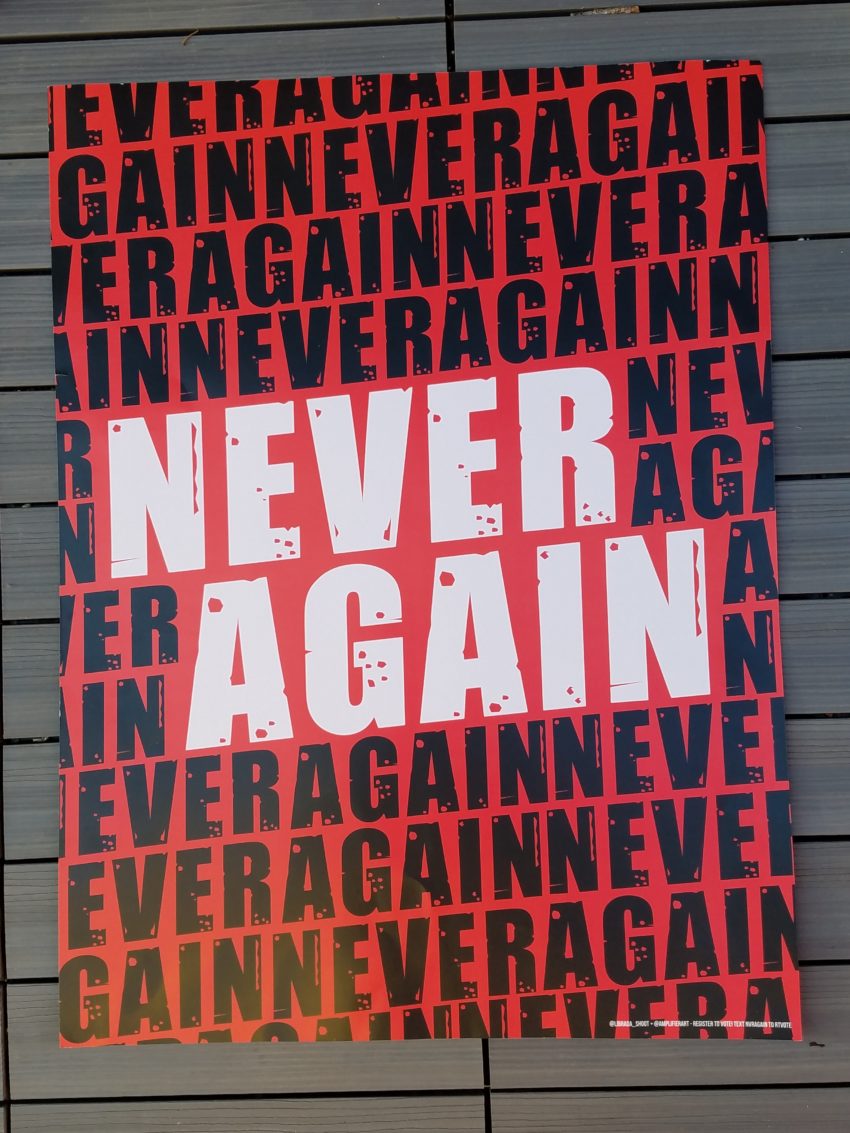
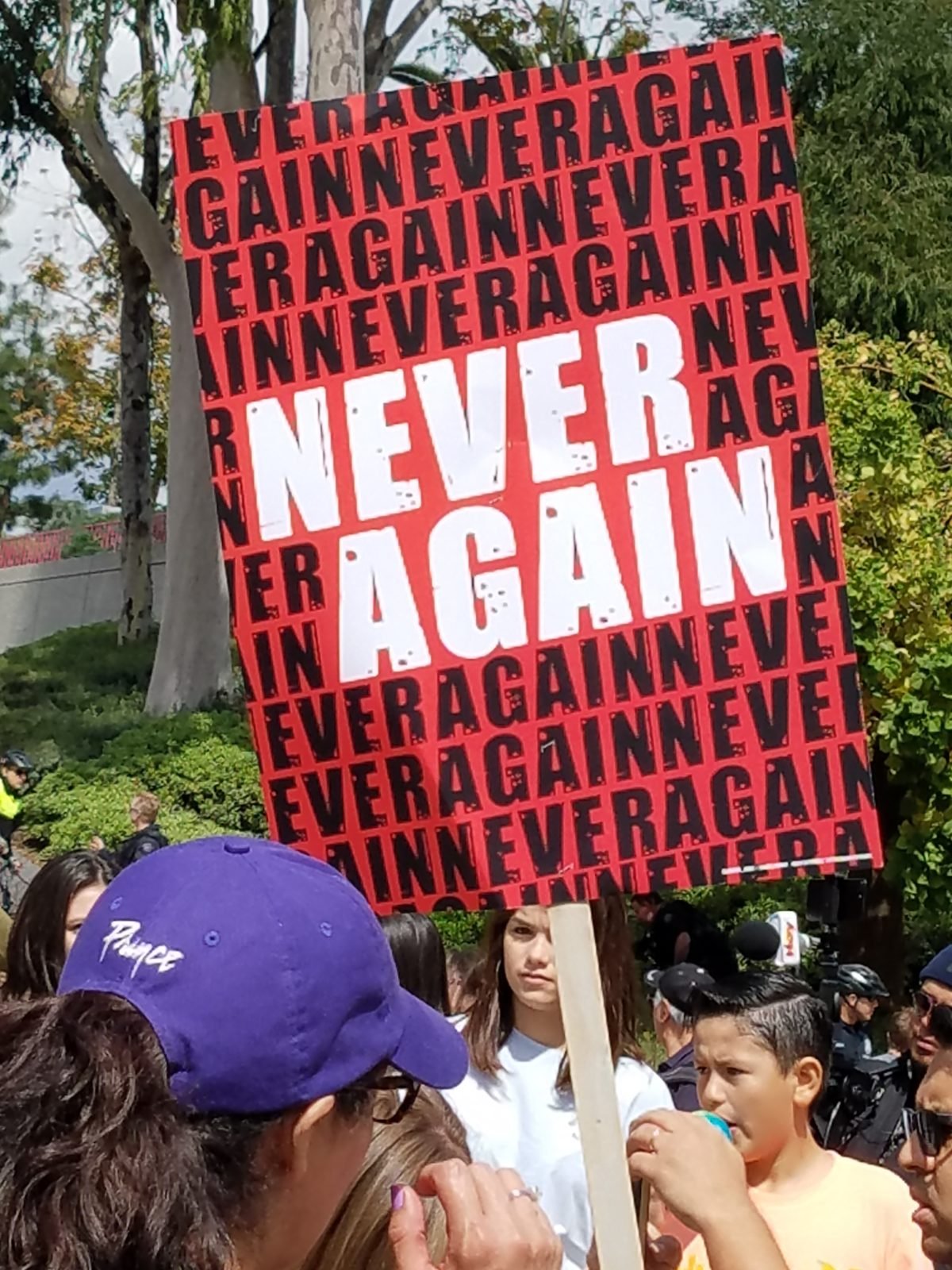
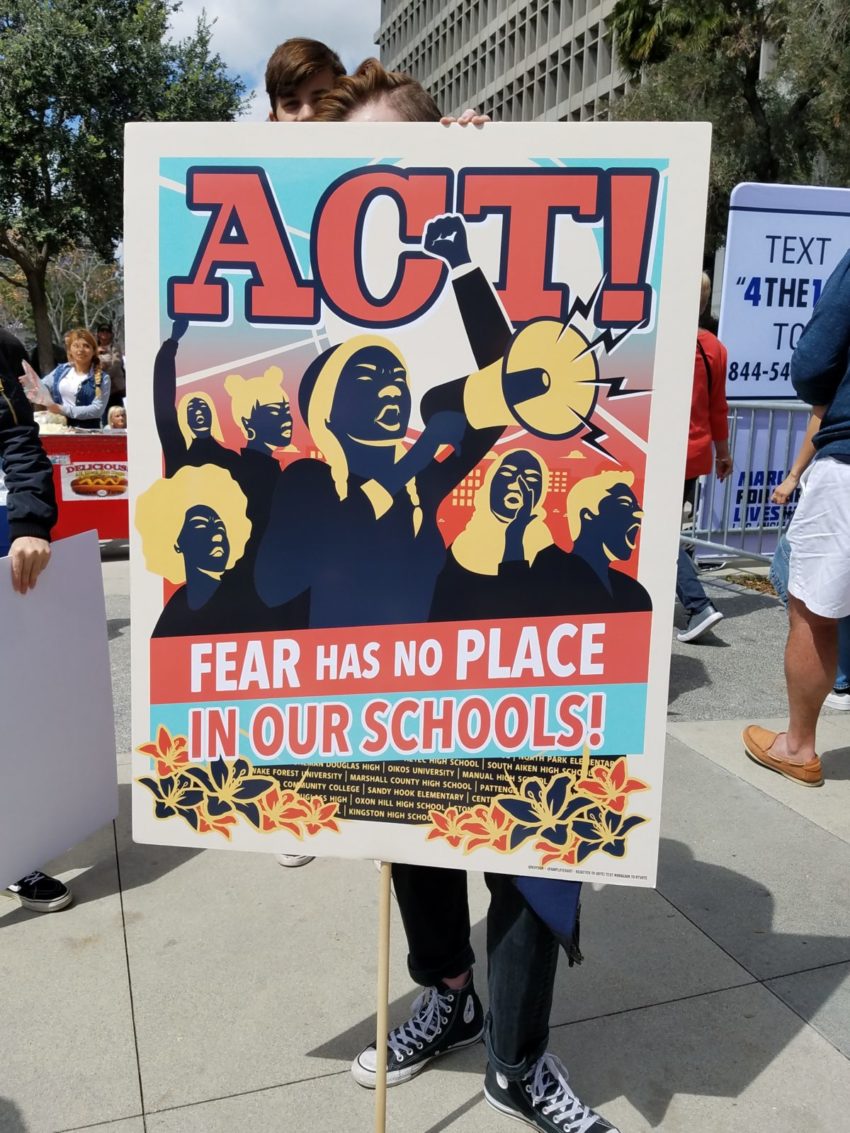

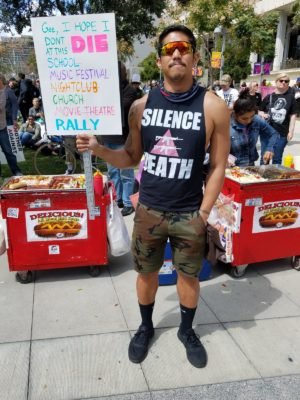



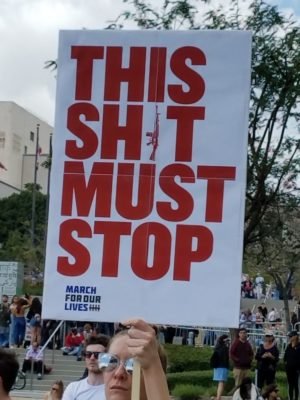
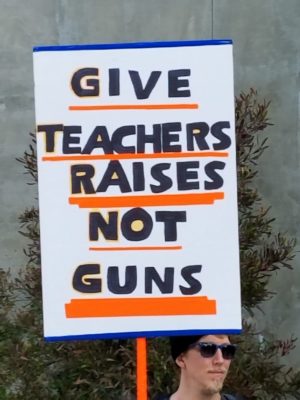

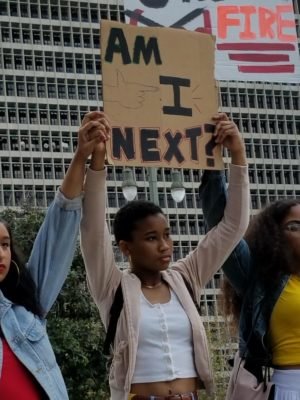


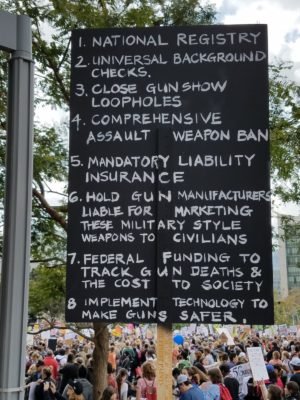
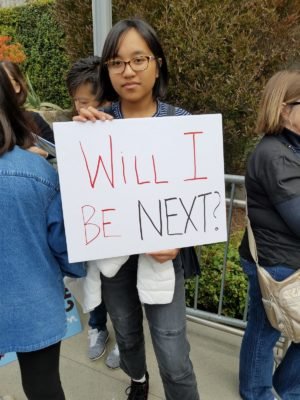






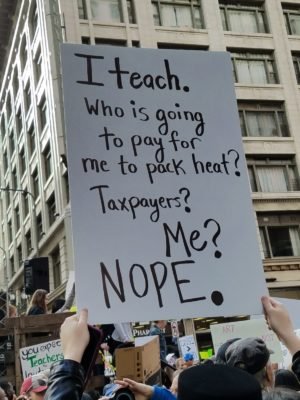
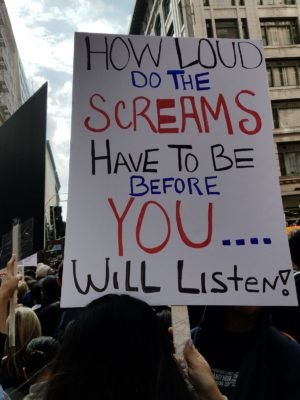

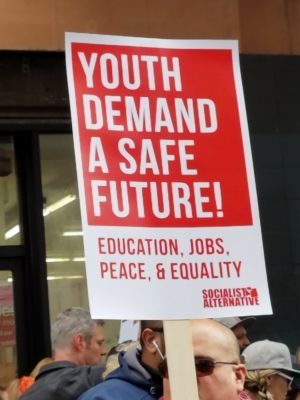


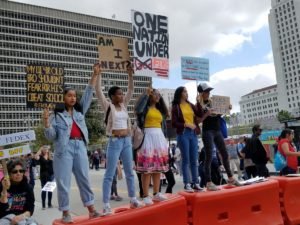




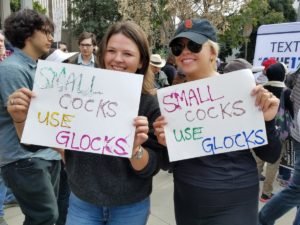




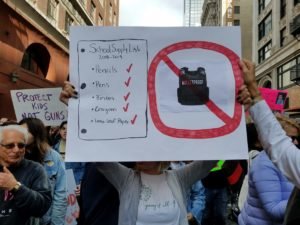
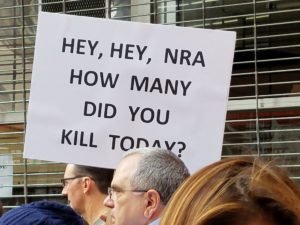
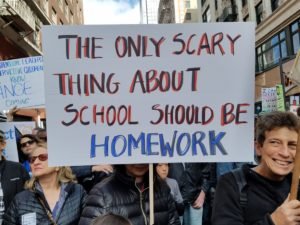
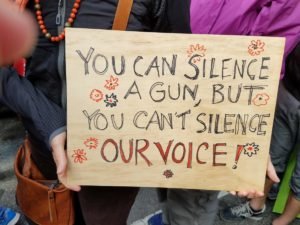

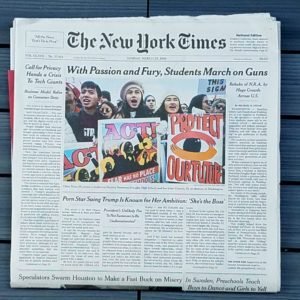
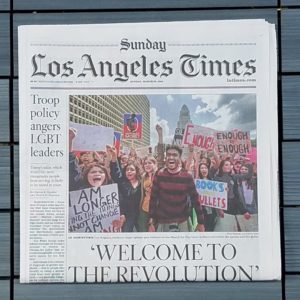
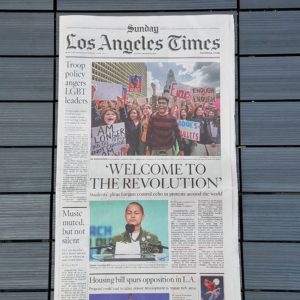
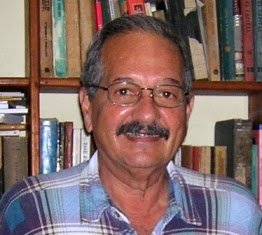
You must be logged in to post a comment.